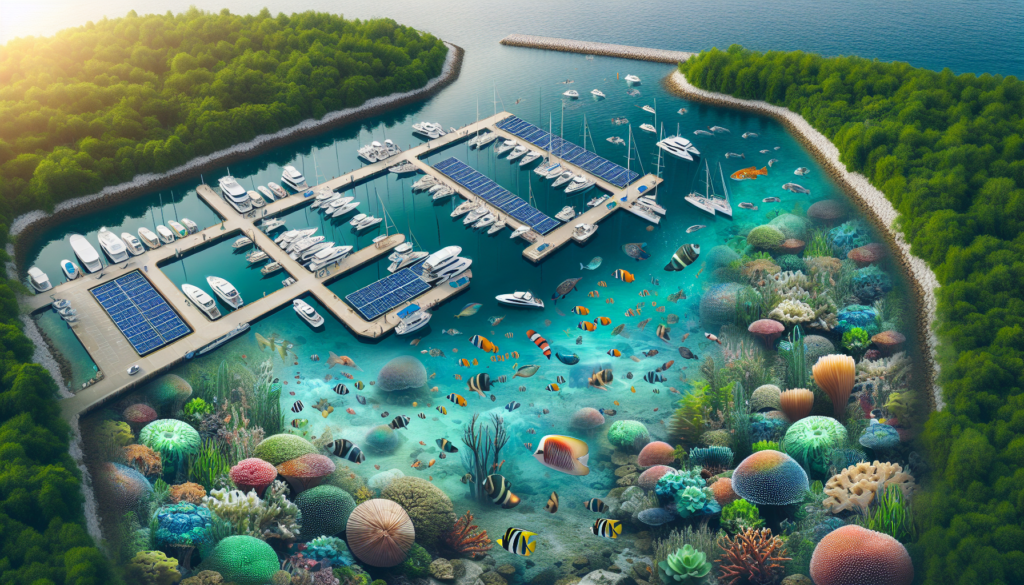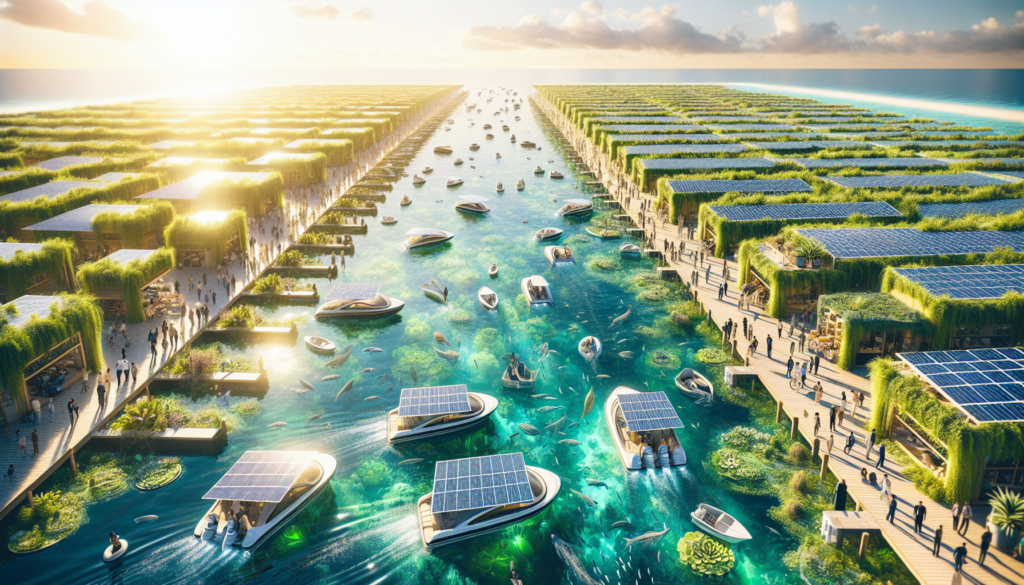As you embark on your journey through the world of eco-friendly boating communities, prepare yourself to navigate the waters of sustainable practices and innovative examples. This article will guide you through the fascinating landscape of green initiatives in marine communities, showcasing how they’re making waves to protect our planet. Brimming with inspiring case studies and best practices, “Eco-Friendly Boating Communities: Examples and Best Practices” is your compass towards a more sustainable maritime lifestyle. Let’s set sail and explore how boaters around the world are steering towards a more sustainable future.

Understanding Eco-Friendly Boating Communities
You’ve likely heard about eco-friendly boating communities, but you might wonder what exactly they are and why they are so important. Let’s break it down for you. Eco-friendly boating communities are, basically, groups of boaters and marina operators who are dedicated to protecting and preserving the marine environment. As opposed to conventional boating practices, these communities engage in environmentally sustainable practices in all aspects of boating, from propulsion systems to waste management. The reason why these communities have gained traction in recent years is simply because our marine ecosystems are under threat due to human activities, and boating is no exception.
Definition and Importance of Eco-Friendly Boating Communities
An eco-friendly boating community isn’t just about using green technology and renewable resources. It’s about fostering a shared mindset and commitment to protect marine ecosystems among all community members. It’s about keeping the waters clean and safe for everyone — for aquatic life, for boaters, for generations to come. It’s incumbent upon us to minimize our environmental footprint and ensure that our passion for boating doesn’t put the fragile marine ecosystems at risk.
Impacts of Boating Activities on Marine Ecosystems
Did you know that boating can have a significant impact on marine life? Think about the waste, noise, oil spills, and habitat destruction that can come from boating activities. It’s not a pretty picture. Fuel leaks and emissions can contaminate the water, while excessive speed can lead to noise and wave disturbances affecting aquatic life. Furthermore, improper waste management can lead to littering, while hazardous substances from boat maintenance can pose risk to water quality.
How Eco-Friendly Practices can Reduce Damages
The good news is that we can change this narrative through eco-friendly boating practices. By utilizing renewable energy sources, minimizing waste, observing speed limits, and using non-toxic cleaning agents, we can significantly reduce the impact of boating on our waters. It’s not just about being eco-friendly; it’s about treating our waterways with the respect they deserve.
Characteristics of Eco-Friendly Boating Communities
What does it take to be an eco-friendly boating community? Let’s dive into the key defining features.
Adherence to Environmental Regulations
First and foremost, eco-friendly boating communities are stringent about adhering to environmental regulations at both local and international levels. From fuel emission standards to waste disposal rules, every procedure is followed diligently to minimize environmental harm.
Use of Sustainable Materials and Propulsion Systems
Moving on, these communities are big advocates of using sustainable materials and propulsion systems. You’ll find them using biofuels, solar and wind-powered boats, among others. The goal here is to reduce carbon emissions and drive towards clean energy.
Adoption of Eco-Efficient Docking Solutions
Eco-friendly communities also prioritize eco-efficient docking, which means utilizing structures that have minimal impact on the surrounding aquatic environment. This can include floating docks, runoff water management systems, and conservation techniques to limit power and water use.
Waste Management Practices
Lastly, responsible waste management is at the core of every eco-friendly boating community. Whether it’s trash, sewage, or oil spills, these communities have meticulous procedures for handling and disposing of waste to minimize pollution.
Examples of Eco-Friendly Boating Communities
Now that you know what defines an eco-friendly boating community, let’s take a look at some examples.
Florida Green Marina Program
This notable eco-friendly initiative in Florida encourages marinas, boaters, and the public to protect Florida’s natural resources. The program recognizes marinas implementing environmental best practices, such as using renewable energy sources, recycling, and adopting responsible waste management procedures.
The Eco-Marina in Denmark
Denmark is home to the Eco-Marina, known for its stringent ecological, environmental, and social sustainability standards. Rainwater and solar energy are used extensively, recyclables are separated meticulously, and the entire marina operates on the principles of circular economy.
The Blue Flag Marina Scheme in Spain
The Blue Flag scheme in Spain rewards marinas for compliance with a host of environmental, safety, and accessibility standards. It is internationally recognized and operates under the principles of education, sustainability, safety and quality.
The Southern California Clean Marinas Program
Over in California, the Clean Marinas Program sets the standards for environmental stewardship among marinas on the West Coast. With a focus on waste management, stormwater control and habitat enhancement, this program epitomizes the green boating movement.

Eco-friendly Vessels and Propulsion Systems
A key pillar of any eco-friendly boating community is the use of eco-friendly technology and materials. Here’s a look into what goes into creating environmentally friendly boats and propulsion systems.
Electric Boats and Hybrid Systems
Electric and hybrid boats are gaining popularity as an environmentally friendly alternative to traditional fuel-powered boats. They produce zero emissions, are more economical over the long term and significantly quieter— reducing noise pollution.
Solar and Wind-Powered Boats
Solar and wind-powered boats are another excellent example of sustainable boating. These boats use the power of the sun or wind to propel and are not only silent but emission-free too.
Use of Biofuels and Natural Gas in Boats
Biofuels and natural gas are viable sustainable alternatives for boats as well. While biofuels are derived from renewable sources like crop residues and waste oils, natural gas is cleaner-burning compared to traditional boat fuels.
Use of Sustainable Materials in Boating
The materials used in boat manufacturing also have a significant impact on the environment. The trend in eco-friendly communities is toward using more sustainable materials.
The Use of Marine-Grade Stainless Steel
Marine-grade stainless steel is one such material. It is long-lasting, corrosion-resistant and fully recyclable, making it an excellent choice for green boat building.
Eco-Friendly Boat Finishes and Paints
Eco-friendly boat finishes and paints are another area where boat owners can make a difference. These products are made without harmful chemicals thus reducing environmental impact.
Recycled Plastic and Bio-Composite Materials
The use of recycled plastics and bio-composites is a relatively new but promising trend in the boating industry. These materials, derived from renewable sources, can offer a greener alternative to traditional boat building materials.
Eco-Efficient Docking Solutions
In an eco-friendly boating community, even the way boats dock is subject to sustainable practices. Let’s delve into some of the eco-efficient docking solutions these communities use.
Floating Docks and Renewable Materials
Floating docks, made with renewable materials, are a popular choice due to their minimal environmental impact. They don’t affect the seabed and can adapt to fluctuating water levels.
Runoff Water Management Systems
Runoff water, if not managed properly, can pose significant environmental risks. Eco-friendly marinas invest in effective runoff water management systems to prevent contamination of local waterways.
Power and Water Conservation Techniques on Docks
Conservation of power and water is another priority. This can involve anything from LED lighting systems to rainwater capture and reuse systems.
Waste Management Practices in Boating
Every eco-friendly boating community pays special attention to waste management. They not only aim to reduce waste generation but also ensure its proper disposal.
Trash and Recycling Practices
Boaters are encouraged to separate their trash and make use of designated recycling facilities. Biodegradable products are preferred whenever possible.
Sewage Treatment and Disposal Systems
Special care is given to sewage treatment. Boats are equipped with onboard sewage treatment systems or use pump outs available at marinas.
Oil and Fuel Spill Prevention and Cleaning
Preventing and managing oil and fuel spills is paramount. Spill response plans are in place, and prevention is emphasized through regular maintenance and careful fuel handling.
Community Engagement in Environmental Conservation
Fostering a conservation mindset among community members is key to sustainable boating. Here’s how eco-friendly boating communities nurture this:
Educational Programs for Boaters
Education is a powerful tool for building awareness. Workshops and training programs help boaters understand the environmental impacts of their actions and learn best practices.
Community Clean-up Events and Service Projects
Clean-up events and service projects are a great way for boaters to contribute to conservation efforts firsthand. They foster a sense of community and responsibility towards the environment.
Partnerships with Local Environmental Groups
Partnerships with local environmental groups amplify the efforts of eco-friendly boating communities. They bring in fresh perspectives, resources and help push for relevant policy changes.
Local and Global Regulations for Eco-Friendly Marinas
Eco-friendly boating practices are not only voluntary but also mandated by local and international regulations. Here are some key regulatory entities to know.
US Environmental Protection Agency Guidance
The US EPA provides guidelines for several aspects of green boating, from oil pollution prevention to stormwater management. Compliance provides a basic standard for environmental stewardship.
European Union Regulations
EU has strict regulations for managing and reducing environmental impacts of boating. This encompasses guidelines for waste management, designs for energy efficiency and usage of hazardous substances.
International Maritime Organization Standards
The IMO sets global standards for safe and secure shipping which also includes environmental considerations. They focus on preventing and reducing marine pollution from ships.
Future Trends in Eco-Friendly Boating
Sustainable boating holds promising potential for the future. Let’s take a quick look at what lies ahead.
Promising Innovations in Eco-Friendly Boating
Innovations are constantly pushing the boundaries of eco-friendly boating. Think autonomous electric boats, next-gen biofuels, and new materials making boating even more sustainable.
The Roles of Technology and Research in Sustainable Boating
Technological advancements and research are crucial for driving sustainable boating forward. Through these, we can uncover better ways of doing things and continuously improve upon the current practices.
Anticipated Regulatory Changes and their Impacts
As environmental consciousness grows, regulations will likely get stricter. This can result in greater enforcement of eco-friendly practices and lower allowances for pollution, thus accelerating the move towards sustainable boating.
In conclusion, eco-friendly boating communities are adopting a whole new way of interacting with our marine environments. They are pioneering green initiatives, adhering to stringent regulations, and fostering a culture of environmental consciousness. With continued innovation and a collective effort, a future with entirely sustainable boating is not beyond our reach. So, let’s embrace the wave and chart a course for a cleaner, greener future on the waters.


[…] are embracing environmentally friendly practices. This shift is majorly influenced by the Eco-Friendly Boating Regulations which determine how you can make your boating more sustainable while remaining compliant. The rules […]
[…] health as a vital component of the boating industry’s long-term success. By adopting sustainable boating practices and regulations, marine environments can thrive, benefiting boaters and the broader […]